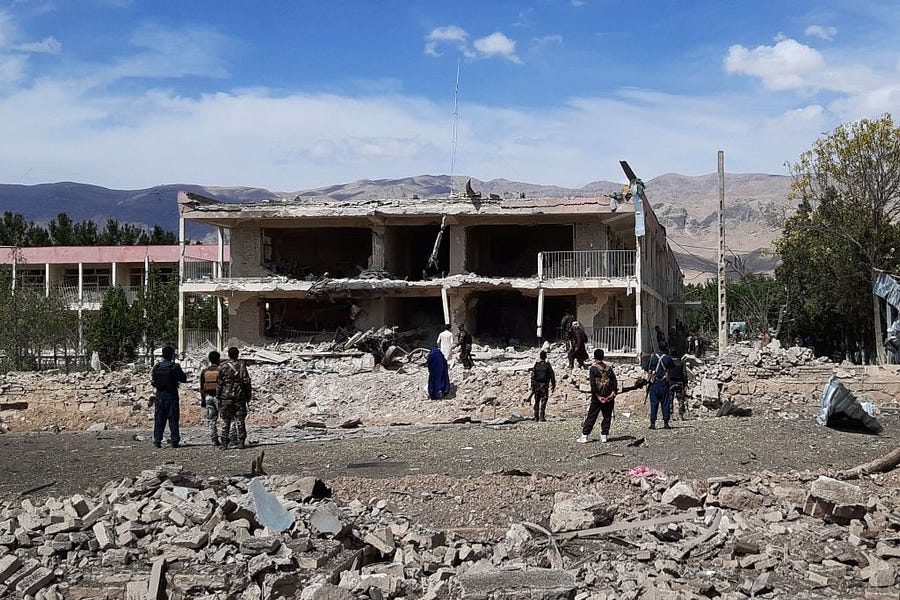For the past two decades, the Taliban and al-Qaeda have waged an insurgency against the Afghan government. They have pursued a fairly basic strategy: Seize the rural areas while preparing the ground for an assault on population centers. They have woven nooses around at least several of Afghanistan’s provincial capitals, knowing that they would eventually tighten the rope. That day has come.
That dire situation is described in the latest quarterly report released by the lead inspector general for Operation Freedom’s Sentinel. That’s the lofty name chosen for the war effort in Afghanistan after Operation Enduring Freedom ended in 2015. But the forces of freedom are not on the march inside Afghanistan. The jihadis are.
The report cites the Defense Intelligence Agency’s (DIA) assessment of the “Taliban’s military strategy,” which “very likely focuses on preparation for large-scale offensives against provincial centers,” as well as “complex attacks” on Afghan security forces.
“As of February 2021,” the report reads, “the Taliban had surrounded the provincial capitals of Baghlan, Helmand, Kandahar, Kunduz, and Uruzgan provinces, and conducted attacks against military and intelligence targets.” Population estimates vary, but those cities house at least hundreds of thousands of civilians. While life is far from idyllic, to date, those Afghan citizens have not had to live under jihadi rule, with its harsh punishments and complete oppression of women. That could soon change.
And that may be the best-case scenario.
My colleague Bill Roggio has tracked the war at a district level for many years. Bill assesses that 17 of Afghanistan’s 34 provincial capitals are now under direct Taliban threat. Moreover, it appears that the Taliban and its allies are clearing out the southern approach to Kabul, the capital of the country. Most of the districts south of Kabul are now, at a minimum, contested by the insurgents. This raises the possibility that the jihadis could make a quick push for Kabul in an attempt to deliver a knockout blow to the Afghan government.
The inspector general’s report contains another noteworthy observation. According to an analysis performed by the DIA, the Taliban has “maintained close ties with al Qaeda” and the two groups “have reinforced ties over the past decades, likely making it difficult for an organizational split to occur.”
The DIA’s assessment directly contradicts testimony provided by Zalmay Khalilzad, the U.S. special representative for Afghanistan reconciliation. Working under the direction of then Secretary of State Mike Pompeo, Khalilzad negotiated the February 29, 2020, withdrawal deal between the Trump administration and the Taliban. By coincidence, Khalilzad testified before the U.S. House of Representatives Committee on Foreign Affairs the same day that the inspector general’s report was released.
Under questioning from the Foreign Affairs Committee Chair Rep. Gregory Meeks (D-New York), Khalilzad explained that the withdrawal agreement contains several counterterrorism assurances. “Our agreement specifies that the Taliban will not host, will not allow training, will not allow fundraising, will not allow recruitment of terrorists, including al-Qaeda, that would threaten the security of the United States and our allies,” Khalilzad said.
Meeks asked if the Taliban had done anything to satisfy these terms—anything at all. Khalilzad couldn’t provide a single example. “Mr. Chairman, what I can say in this setting is that they have made substantial progress in delivering on those commitments, but we would like to see more,” Khalilzad responded.
No other U.S. official has said that the Taliban has made “substantial progress” on its commitments. In fact, every other official assessment released to the public has pointed to the unbroken alliance between the Taliban and al-Qaeda. There is a wealth of additional evidence showing that the two remain in the same trench.
Khalilzad’s response—claiming what he could say was limited “in this setting”—implies that he is privy to classified intelligence showing that the Taliban is secretly complying with the counterterrorism provisions of the deal. There is no good reason to believe that is true. Al-Qaeda continues to fight alongside the Taliban day in and day out. They are blood brothers and al-Qaeda has dedicated its resources to resurrecting the Islamic Emirate of Afghanistan—the totalitarian state that was overthrown by the U.S. and its allies in late 2001.
None of this dissuaded President Biden from ordering a full withdrawal this year. The president thinks America will be able to continue to monitor terrorist threats from “over the horizon.” That will be difficult for many reasons. For starters, the U.S. military doesn’t even know if it will be able to base limited forces elsewhere in the region.
The bottom line is: No one should think that Khalilzad’s deal led to a real break between the Taliban and al-Qaeda. And the jihadis are jointly preparing to take over much of Afghanistan once again.
The Biden administration designates Iranian-backed Houthi leaders as terrorists, after delisting the group.
During the first month of the Biden administration, Secretary of State Anthony Blinken announced that the U.S. government was revoking the terrorist designations of Ansarallah, more commonly known as the Houthis in Yemen. Blinken cited humanitarian concerns, namely “that the designations could have a devastating impact on Yemenis’ access to basic commodities like food and fuel.” It’s not clear that was true, as U.S. terrorist designations and sanctions often provide carve-outs for humanitarian goods.
In any event, the revocation was a reversal of a move made late in the Trump administration, when Secretary of State Mike Pompeo had Ansarallah added to the U.S. government’s official lists of terrorist organizations. This was part of Pompeo’s campaign against the Iranian regime, as he rightly concluded that the Houthis are heavily supported by Tehran.
On that count, even though the Houthis are no longer officially included on the U.S. government’s lists of terrorist organizations, the Biden administration continues to designate its leaders—specifically citing their ties to the Iranians.
The latest designations were issued on Thursday (May 20), when Blinken announced that “two senior leaders of Houthi forces in Yemen” had been designated as terrorists due to their involvement “in military offensives that exacerbate the humanitarian crisis, pose a dire threat to civilians, and destabilize Yemen.”
That is, the Houthi leaders exacerbated the very same crisis that Blinken hoped to ease by revoking the terrorist designation for the overall group.
The two newly designated terrorists are Muhammad Abd Al-Karim al-Ghamari and Yusuf al-Madani, both of whom are responsible for overseeing the Houthis’ offensive in Yemen’s Marib governorate. “The Marib offensive is exacerbating Yemen’s humanitarian crisis, as it puts approximately one million vulnerable internally displaced people at risk of being displaced yet again, threatens to overwhelm an already stretched humanitarian response, and is triggering broader escalation,” Secretary Blinken said in his statement announcing the designations.
And the Iranians are culpable. “The Houthis benefit from generous military support from the Iranian government to wage attacks against civilian population centers and commercial shipping infrastructure in Yemen, exacerbating conditions in what the United Nations calls one of the world’s worst current humanitarian disasters,” Blinken said.
Blinken similarly pointed to Iranian support when designating two other Houthi leaders as terrorists in early March. They are Mansur Al-Sa’adi and Ahmad Ali Ahsan al-Hamzi, who oversee the Houthis’ naval and air forces, respectively. As senior Houthi military leaders, Blinken said, the pair have procured “weapons from Iran and to oversee attacks threatening civilians and maritime infrastructure.”
Blinken added: “Iran’s involvement in Yemen fans the flames of the conflict, threatening greater escalation, miscalculation, and regional instability. Ansarallah uses Iranian weapons, intelligence, training, and support to conduct attacks threatening civilian targets and infrastructure in Yemen and Saudi Arabia.”
In the past, some commentators tried to downplay the degree of Iranian support for the Houthis. Thus far, the Biden State Department isn’t playing that game.






Please note that we at The Dispatch hold ourselves, our work, and our commenters to a higher standard than other places on the internet. We welcome comments that foster genuine debate or discussion—including comments critical of us or our work—but responses that include ad hominem attacks on fellow Dispatch members or are intended to stoke fear and anger may be moderated.
You are currently using a limited time guest pass and do not have access to commenting. Consider subscribing to join the conversation.
With your membership, you only have the ability to comment on The Morning Dispatch articles. Consider upgrading to join the conversation everywhere.